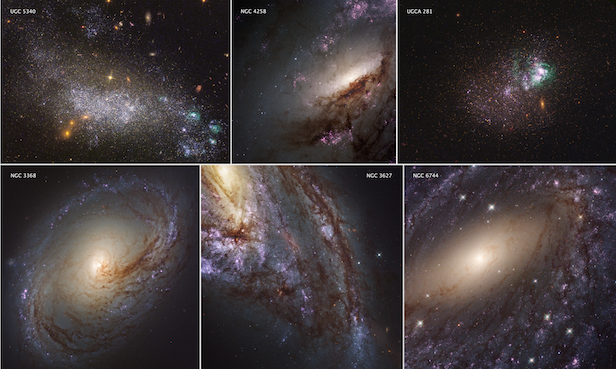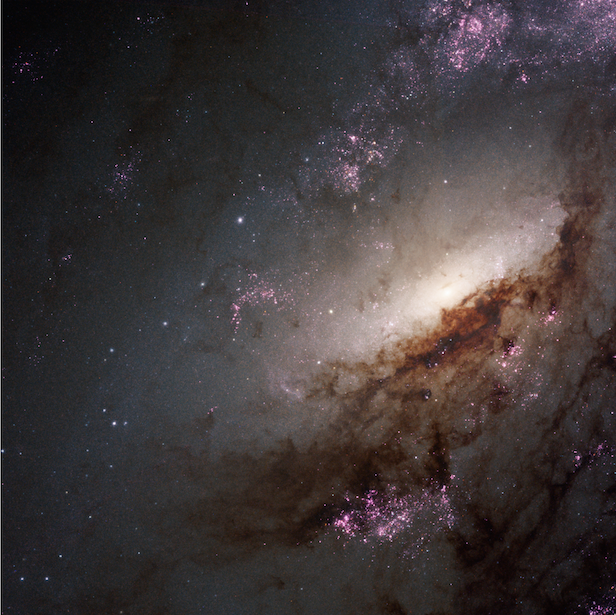Hubble compiles a complete ultraviolet catalogue of galaxies
50 galaxies within our cosmic backyard have been studied extensively in visible and ultraviolet images

Six of the 50 nearby galaxies showcased here are part of the Hubble Space Telescope’s Legacy Extragalactic UV Survey (LEGUS). Image credit: NASA/ESA/LEGUS
NASA and ESA’s Hubble Space Telescope offers a unique ultraviolet perspective when studying celestial objects, and this has been utilised by an international team of astronomers to produce a survey of nearby star-forming galaxies. Combining fresh and archival Hubble observations, astronomers have now created the most comprehensive collection of star-forming galaxies with extremely high-resolution images.
50 spiral and dwarf galaxies within our local universe were observed as part of this survey, and it can now be used as a valuable resource when scientists wish to study the complexities of star formation and galaxy evolution. The project has been designated the Legacy ExtraGalactic UV Survey (LEGUS) and has collected a large amount of data on this matter. LEGUS has accumulated star catalogues for each of the LEGUS galaxies and cluster catalogues for 30 of the galaxies, also included are images of the galaxies themselves.
“There has never before been a star cluster and a stellar catalogue that included observations in ultraviolet light,” explains survey leader Daniela Calzetti of the University of Massachusetts, Amherst, United States. “Ultraviolet light is a major tracer of the youngest and hottest star populations, which astronomers need to derive the ages of stars and get a complete stellar history. The synergy of the two catalogues combined offers an unprecedented potential for understanding star formation.”
“Much of the light we get from the universe comes from stars, and yet we still don’t understand many aspects of how stars form,” says team member Elena Sabbi of the Space Telescope Science Institute in Baltimore, Maryland, United States. “This is even key to our existence – we know life wouldn’t be here if we didn’t have a star around.”
The LEGUS targets were carefully picked from among 500 candidates which were compiled in ground-based surveys and located between 11 million and 58 million light years from Earth. A variety of conditions were taken into account during the selection process including mass, star-formation rate and abundances of elements heavier than hydrogen and helium. The catalog of the ultraviolet objects collected by NASA’s Galaxy Evolution Explorer (GALEX) spacecraft played a key part this Hubble-led study.
Hubble’s famous Wide Field Camera 3 and Advanced Camera for Surveys were used over a period of one year to image galaxies, their most massive young stars and star clusters in both visible and ultraviolet light. Archive data collected previously by Hubble was also amalgamated in order to tell the full story.

NGC 4258 is a large spiral galaxy that is undergoing intense star formation, and shines brightly in visible and ultraviolet light. Image credit: NASA/ESA/LEGUS
The star catalogues contain 8,000 young clusters with ages ranging from 1 million to approximately 500 million years old. These groups are as much as ten-times more massive than even the largest cluster ever seen in our Milky Way. The star catalogs are made up of 39 million stars, with masses starting at roughly five-times the mass of our Sun. The stars observed in visible light have ages that can range from just 1 million to several billions years old. The youngest stars that have ages between 1 million and 100 million years old emit most of their light in ultraviolet.
“We also are offering computer models to help astronomers interpret the data in the star and cluster catalogues,” says Sabbi. “Researchers, for example, can investigate how star formation occurred in one specific galaxy or a set of galaxies. They can correlate the properties of the galaxies with their star formation. They can derive the star-formation history of the galaxies. The ultraviolet-light images may also help astronomers identify the progenitor stars of supernovas found in the data.”
One of the fundamental questions astronomers hope to answer with the help of this survey is the link between star formation and the major structures, for example spiral arms, which comprise a galaxy. “When we look at a spiral galaxy, we usually don’t just see a random distribution of stars,” says Calzetti. “It’s a very orderly structure, whether it’s spiral arms or rings, and that’s particularly true with the youngest stellar populations. On the other hand, there are multiple competing theories to connect the individual stars in individual star clusters to these ordered structures.
“By seeing galaxies in very fine detail – the star clusters – while also showing the connection to the larger structures, we are trying to identify the physical parameters underlying this ordering of stellar populations within galaxies. Getting the final link between gas and star formation is key for understanding galaxy evolution.”
Astronomers also hope the LEGUS survey will be helpful in interpreting the views of more distant galaxies. The more distant galaxies tend to have their ultraviolet emission wavelengths stretched into infrared due to the expansion of the universe. The data in the star and cluster catalogues of these nearby galaxies will help pave the way for what we see with NASA’s upcoming infrared observatory, the James Webb Space Telescope, developed in partnership with ESA and the Canadian Space Agency (CSA),” says Sabbi.
The James Webb Space Telescope would be able to observe the infrared glow of young stars trapped inside dusty stellar cocoons, which cannot be observed in visible and ultraviolet images. “Webb will be able to see how star formation propagates over a galaxy,” Sabbi continues. “If you have information on the gas properties you can really connect the points and see where, when and how star formation happens.”
Keep up to date with the latest reviews in All About Space – available every month for just £4.99. Alternatively you can subscribe here for a fraction of the price!




